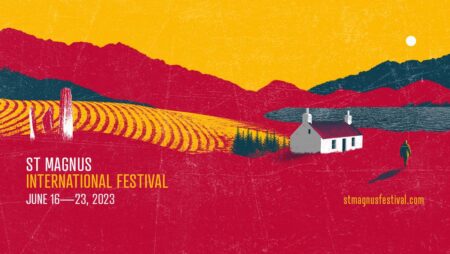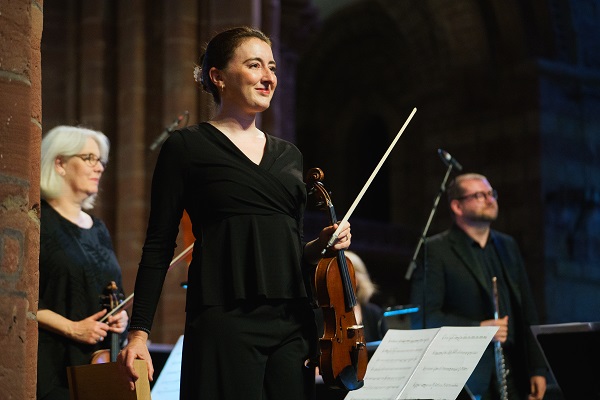
 United Kingdom St Magnus Festival 2023 [2]: (ST)
United Kingdom St Magnus Festival 2023 [2]: (ST)

Ragazze String Quartet – Stromness Town Hall, 18.6.2023.
Mozart – String Quartet No.14 ‘Spring’
Widmann – String Quartet No.4
Schubert – String Quartet No.14 ‘Death and the Maiden’
Findlay Spence (cello) – St Peter’s Kirk, South Ronaldsay, 19.6.2023.
Works for solo cello by Bach, Boyle, Britten, Morrison and Wilde
Hebrides Ensemble – St Magnus Cathedral, Kirkwall, 19.6.2023.
Debussy – Danses Sacre et Profane
Ravel – Introduction and Allegro; Le Tombeau de Couperin (arr. Alasdair Nicolson); Music from Mother Goose (arr. Alasdair Nicolson)
It is the strong sense of place that has struck me most in my first visit to Orkney’s St Magnus Festival, a sense of the performances being rooted in the community and the landscape of some of Britain’s most rugged, windswept landscape. Findlay Spence’s cello performances on Hoy epitomised that in the festival’s opening weekend, and he took his cello to another remote corner of the archipelago for the next instalment on Monday.
This time it was over the Churchill Barriers to the isle of South Ronaldsay. The barriers are a series of causeways built during the Second World War to link the islands of Orkney’s southeast, and in the process to block one of the entrances to Scapa Flow, thereby protecting the Grand Fleet that was stationed there. St Peter’s Kirk sits on South Ronaldsay’s windswept east coast, looking out over the endless, grey of the North Sea with forbidding sea cliffs stretching into the distance to the left and right. The Kirk sits at the end of an isolated road, presiding over the island’s main cemetery, though it no longer houses regular services. There is a double sense of isolation to it, therefore, which makes it an all-the-more-unlikely venue for a concert.
However, that also makes what happens there even more cherishable. Spence is a subtle musician, who has the ability to get inside the music he plays and to illuminate its textures from within. That was striking in his Hoy performances, and even more so here, with a gorgeously supple performance of Bach’s Cello Suite No.3 which complemented an altogether darker reading of Britten’s third suite. Where Bach smiles, Britten seems to grieve, and Spence didn’t shun the weighty darkness of Britten’s music. He retained the poetry amidst the often fiercely aggressive writing, however, and kept his eye on the vein of lyricism that ran right through it. Rory Boyle’s lovely Baloue and David Wilde’s The Cellist of Sarajevo sat next to the first performance of Fadhall, a work by Padruig Morrison, Spence’s roommate at music school. It was inspired by the treacherous tides and ceaseless rhythms of Scotland’s Western Isles, and the shudders and shimmers the Spence evoked from his cello touched on both the danger and beauty of the inspiration.
Spence played in several concerts over three days during his time at the St Magnus Festival, and the festival is doing its best to build multi-concert residencies with its artists rather than hit-and-run concerts that you might get from bigger names in better connected cities. It is desirable due to the complexity of travelling to Orkney, but it also feeds helpfully into the wider sustainability agenda. So the ladies of the Ragazze String Quartet played three concerts over the opening weekend, too, one of which also called on pianist Nikola Meeuwsen to join them for Shostakovich’s G minor Piano Quintet.
I heard them playing Mozart, Schubert and Widmann in Stromness Town Hall, a converted church with a warm acoustic that comes from having so much wood in it. The Ragazze opened their concert with gorgeous, sunny Mozart where the sense of interplay between the four musicians was palpable. That wasn’t quite so evident in Schubert’s Death and the Maiden, however, which rarely settled and had a rather slipshod approach to both ensemble and shape, though they pulled it together for a dashing Saltarello finale. I doubt the good burghers of Stromness will have ever heard anything like Jörg Widmann’s String Quartet No.4, with its abstract musical language and its many unusual sounds, such as the swish of the bows in the air or bowing the side of the instrument to make it sound like rhythmic walking. It was effective in places, if often rather batty, though I couldn’t help but think of the other Widmann works I have heard that ask the musicians to use similar non-musical effects like rhythmic breathing or hitting unconventional parts of their instruments. That works well enough in its way, but once it loses its surprise value you start to wonder whether if there’s really very much beneath it.
My final concert at this year’s festival returned to what is effectively its central venue, the majestic cathedral of St Magnus at the heart of Kirkwall. The magical acoustic of this building keys into that all-important sense of place as much as do its soaring arches and vaulted ceiling, and it was terrific for some music in which the harp played a central role.

The Hebrides Ensemble is a flexible group of soloists who form and reform as the occasion and the music demands, and they played Mother Goose and Le Tombeau de Couperin in new arrangements by Alasdair Nicolson, the festival’s director. Both are tricky candidates for arrangement because they both already exist in several versions. Nicolson wisely chose to stick relatively closely to Ravel’s original orchestral sound pictures, here brought to life by five single strings with harp, flute/piccolo, clarinet and percussion. In truth, the percussion in Le Tombeau felt a little extraneous, even slightly badly behaved in the concluding Riguadon. However, it was indispensable in Mother Goose: percussionist Oliver Cox earned his wage for the night in ‘Laideronette’ alone, so hard did he have to work. Occasionally I missed touches like the flatulent bassoon in ‘Beauty and the Beast’, but otherwise Nicolson did a fine job of giving Ravel’s well-loved music new clothes to wear.
It is the non-arranged pieces I will remember the most, though, partly because they shone such an effective spotlight on the harp playing of Gabriella dall’Olio. Ravel’s Introduction and Allegro is effectively a miniature harp concerto, and she played its myriad rippling arpeggios with easy style. Debussy’s Dances, on the other hand, sounded much more solemn in this huge space, with a quasi-ritualistic element to the stomping harp chords. The element of otherworldly majesty was reinforced and amplified by the cathedral’s huge resonance that seemed to swirl the sound around our ears before letting it gently fade away. There is that sense of place again; both magical and central, right to the end.
Simon Thompson
The St Magnus International Festival runs until 23 June; for more information click here.
